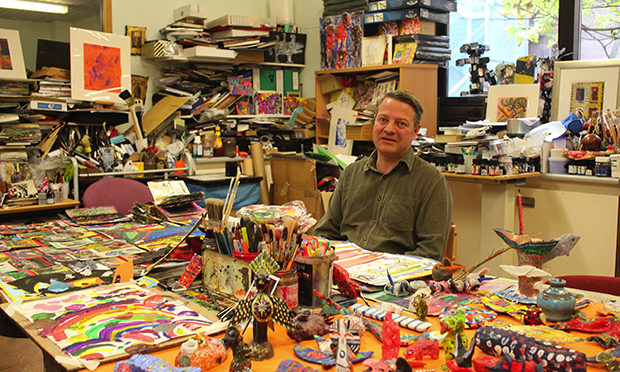
If you’re looking for art, a hospital is not the most obvious port of call. But along the labyrinthine corridors of the Homerton hangs a vast and diverse collection – the envy of any Shoreditch gallery.
Hawk-eyed visitors will spot works by twentieth-century masters among the paintings, drawings and photographs by established artists. But next to canvases by Henry Moore, Burt Irvin and Bruce MacClean are brilliantly original collages and stunning abstract paintings that are far less easy to identify. This is because they are created by true ‘outsider artists’ – the patients themselves.
“People often say that the work by the untrained artist is better than the one by that celebrated Royal Academician,” says the hospital’s art curator Shaun Caton.
We meet at the front of the hospital for a trip to the Regional Neurological Rehabilitation Unit (RNRU), where for over 20 years Caton has been running art workshops for those with traumatic and acquired brain injuries. Patients may have suffered a stroke, a brain aneurysm, been hit on the head or involved in a road traffic accident. Caton aims to bring them back to health through activities that inspire their creative potential.
“This is the only ward that has every single room filled with art made by patients,” says Caton as we enter the RNRU. “As you will see it’s just not possible to display it all – there are around 3000 works, and that’s only the ones on paper.”
Although there is a sizeable collection of art in the hospital by established names, Caton is more interested in works by unknown and untrained artists. We approach a door through which lies the “nerve centre” of the operation, and duly enter.
To step inside Homerton Hospital art room is a bit like entering a secret garden. Abstract paintings of swirling patterns or of strange creatures seem to cover every surface, jostling for space with painted models, knitted fish, handmade books and collages. Paints, brushes and easels fit wherever they can, the makeshift shelves visibly buckling under the weight of art – each piece with a unique story about a person with a serious head injury.
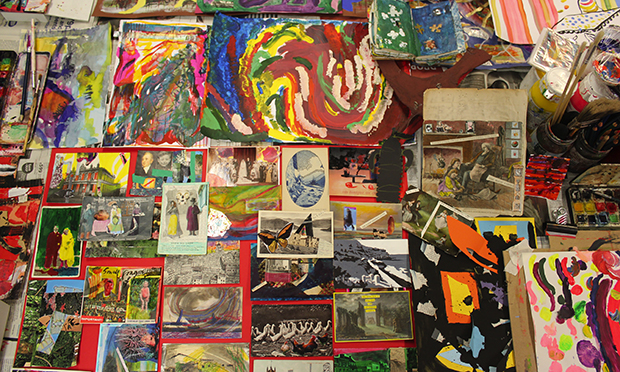
Caton calls the room the “power house of the creative imagination”, and the title is not misplaced. In the 20 or so years of its existence, nearly a thousand artists from Hackney and the East End of London have volunteered their services here.
“We have had sculptors, collage artists, poets, writers, artists who make inventions with machines and installation art, we’ve had sound artists, photographers, print makers, recycled book artists, artists who make art using recycled bus tickets – it’s endless the imaginative scope of things we can introduce here,” Caton enthuses.
The art room started as an experiment to engage patients with behavioural problems, but it soon evolved. Now it treats patients with speech, language and memory problems. Some are semi-paralysed, others may not know the day of the week.
“My job if you like is to find things that suit people’s potential but push them a bit further,” Caton explains, showing me a handmade book filled with patterns, text and collages.
“Let’s say we’re trying to encourage someone to concentrate better, well something like this which requires cutting and placement and judgement and colour will stimulate the brain to work with the hand and the eye to improve coordination.”
One patient, a man from Bethnal Green, had been diagnosed with Guillain-Barré syndrome and had paralysis in his hands. He wanted to paint watercolours and spent all his time in the art room trying to get the feeling back in his fingers. Caton strapped the brushes in his hands with surgical tape and guided them over the paper.
“At first we made what some people would consider to be meaningless scribble, but as time went by he started to regain control of his movements, and was able to execute quite precise designs and illustrations which led to compositions and paintings of a very high standard,” Caton recalls.
The patient, who had no formal training, exhibited his watercolours in the hospital and went on to become an amateur artist once discharged.
Patients are referred for very different reasons: a physiotherapist may want a patient to strengthen their wrist and finger muscles, or a psychologist may refer a patient to improve their social skills.
Most hospitals practise some sort of art therapy, but this is very different: art at the Homerton is used to tackle a wider range of conditions that are not merely psychological. The success of the art room has led to the hospital piloting a similar service for patients with dementia.
Caton’s approach is less rigid than the one-to-one confines of art therapy. Workshops at the Homerton encourage collaboration and social interaction, and cater for several patients at once.
But what really makes it unique are the activities and the range of stimuli used to inspire the patients. We listen to a piece of sound art sent in out of the blue by an unknown composer called Lowell Johnson. It’s an atmospheric urban soundscape, a kaleidoscopic collection of sounds that mirrors the chaos of the mind.
“When you play something like that to a group, people respond to it in a variety of ways. It will automatically trigger conversation and remind people of things, but it’s also probably going to inspire them to make an artwork,” says Caton.
“We’re leagues ahead of other hospitals in that respect. They might just do some paintings of butterflies or some block paintings but we try to provide meaningful activities that are truly extraordinary.”
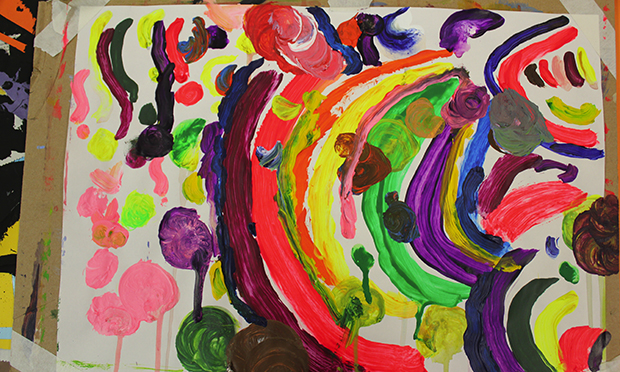
Caton has refused interviews and is wary about talking to journalists. In an age of cuts, hospital art is often seen as being a waste of money.
“Those people need to come and visit this facility and meet the patients and see the evidence for themselves about how this can speed up their recovery programme by improving sense of well being,” he says.
The budget for basic art materials, as well as for framing, mounting, storage and cataloguing the art works is very small. This means Caton has had to raise funds by holding exhibitions and selling greetings cards designed by the patients.
“All these guys who come here and offer their services and time and talent are not being paid,” Caton insists. “They’re not even been paid a cup of tea, I provide that out of my own money. And I provide the biscuits as well, because that’s the way I think it should be.”
Through cuts and all kinds of adversity, the art room has kept going, which Caton puts down to having to be resourceful, and not leaving the lights on.
The situation changed in September, however, when the street artist Stik donated £50,000 by selling off 100 original prints of an NHS-themed mural entitled Sleeping Baby, which is on display in the hospital courtyard.
Members of the public camped out over night, queuing around the block to take home one of the limited edition prints, made by an artist who himself used to volunteer at the hospital.
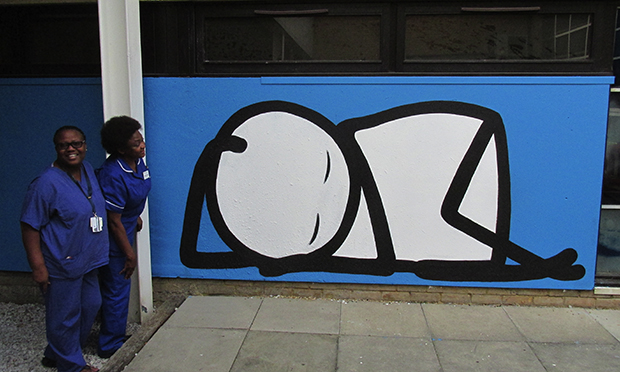
In a speech at the sale, Caton said: “In this hospital there are many patients who need something to focus on, so we offer them art workshops, not just as a recreation or past time, but to help them gain control of their lives again.
“The things that go on in these workshops enhance their concentration, their motor coordination and their general sense of well being. And so the money raised will enable us to buy much needed equipment, materials and really push forward with these services.”
We sit around a table on which there are at least 100 individual art works. The storage racks behind me are falling to bits, on the verge of collapsing under the weight of paper. With Stik’s donation, Caton will finally be able to invest in cataloguing and archiving the art for the benefit of future generations.
It is not an unreasonable ambition. The Bethlem Gallery in Beckenham is home to a fascinating collection of art by mentally ill patients, and in the 1920s the German psychiatrist Dr Hans Prinzhorn amassed a vast collection of his patients’ art that is famous the world over. Why not something similar at the Homerton Hospital for patients with brain injuries and dementia?
“I’d like the general public to know about this collection, what it’s about, who it’s been created by and why we are even bothering to maintain this for posterity,” Caton says. “I feel it should be maintained, because it’s an unknown universe of creative potential. A lot of people in society have an innate hidden creative talent, which can be teased out through art. This is a testament to it.”
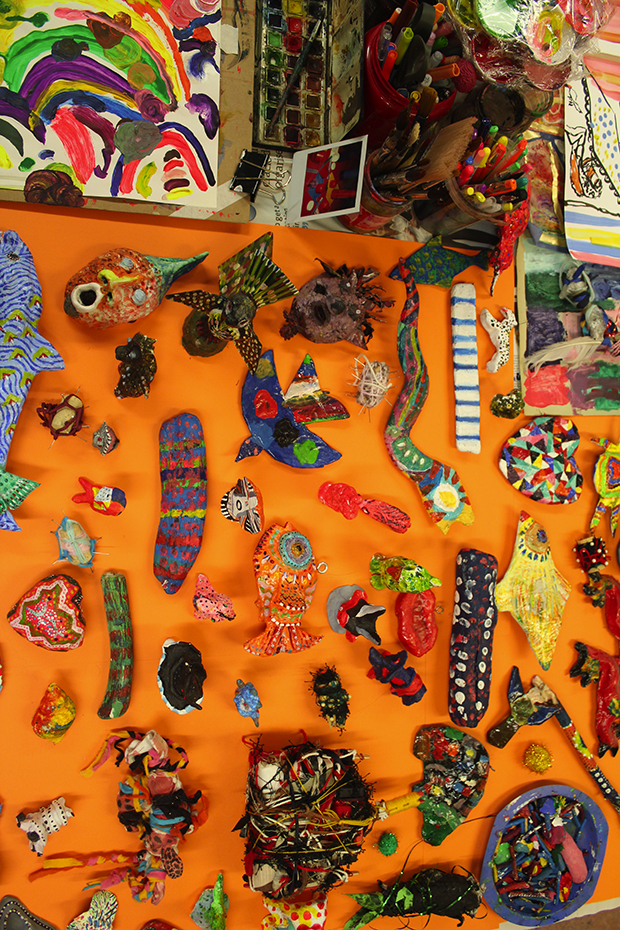

I tried to give a painting to this hospital, but they do not seem to want it if Shaun Caton is anyone to go by
I knew Shaun Caton as a good friend, his art works of any and every dimension are testament to his commitment. A absolutely extraordinary human being and the one person I ever got to know who seen his art as an extension and expression of his being. Unique vision and perception and the trust and total belief thT ‘art’ has a power that nothing on this earth can heal like ‘art’ . A tiny word, three letters, but a whole world full of experiences and colours are brought by each unique artist at shauns domain in Hamerton hospital and elsewhere. He touches and reaches people through this art and others respond now with a new confidence that their unique art work is as pivotal as their mentors and anybody, whether they call themselves an artist or not. Sadly I have lost Shauns trust and we have lost touch I hope one day we will get together to swap ideas and talk ‘art’ which is everything under the stats as far as both of us are concerned. I can only speak of Shaun with the highest regard and know his work is testament to his commitment to all those patients that pass through his workshop and leave with a new belief not only in themselves but with a value that their life matters, and what they do with it matters and their new confidence that each and everyone of those people have this new passion in themselves and the belief that they can change their world and all of our worlds. Art is indeed magic, it is everything we each need it to be and can be anything. Shaun knows this, he lives it, everyday, 24/7. Jan (corvidscuriositycorner@gmail.com)